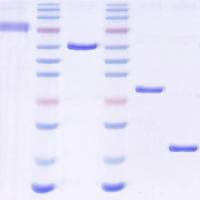Force-Clamp Measurements of ReceptorLigand Interactions
互联网
659
Protein–protein interactions are the basis of both biochemical and biophysical signaling of living cells. In many cases, the receptor is present on the cell surface while the ligand is in solution or linked to another support (extracellular matrix or another cell). In the case of cellular adhesion, forces are continuously applied to receptor–ligand complexes and, as a consequence, the dissociation kinetics of the bonds may change. It is, thus, relevant to study the kinetics of protein–protein interactions in response to applied forces, as this is the most physiologically relevant situation. The atomic force microscope (AFM) was one of the first nanotools to be applied to this end. However, new approaches need to be developed to better understand the complex energy landscape of molecular interactions under applied stress. In this chapter, we described the use of the AFM to carry out force-clamp measurements on receptor–ligand bonds. Force-clamp measurements on bonds consist of applying a constant and controlled force to a receptor–ligand bond and measure the resulting dissociation lifetime. The described methods include the required materials, functionalization of tips and substrates, force-clamping measurements, and processing and interpretation of the results. An illustrative example is given with the well-studied streptavidin–biotin complex.






